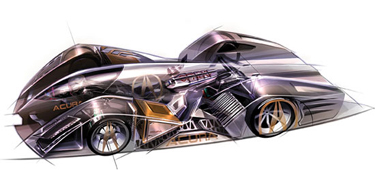Get your motor runnin…Even if it is silent. Fuel cells will finally bring about the “quiet car.” No sound when it “starts up” and none (other than the advanced composite tires on the road) as it moves along. You will, however, be able to broadcast sound effects; give it the sound of a 1970 SS 454 Chevelle, or tune it to be a street racer, or… And you won’t be needing those keys; biometrics will allow your car to recognize you as long as your wrist-comp remains connected to your personal ‘net. Once you approach close enough for the stereoscopic cameras to “verify” you, your car will automatically unlock the doors, prep your specified seat position and controls, upload your destination coordinates, and await your verbal command to get moving. Oh yeah, unless your override, all commands will be verbal, except steering, acceleration, and braking when in manual mode.
Head out on the highway…Well, OK, it’ll be a sensor-monitored and -controlled highway. While drivers from 2007 will recognize it as such, functionally it will be very different. For one, you won’t need to do the driving, your car (assisted by the highway network) will do the driving for you. You’ll get to catch up on your email, do your nails, or any one of a million other tasks, all the while the hwy-net does the work. Need to arrive at your destination in less time than the tourists? No problem, just tell your car to choose one of the faster lanes.
Lookin’ for adventure…How about a 100-mile long public track that simulates various driving conditions, including 90-degree banks, obstacle courses, and virtual landscapes? It will have the same sensor system as the highway, above, but will allow you to control steering, braking, and speed. Your new 2030 Pontiac NanoScorpion (built in a factory by trillions of nanomachines) will take you around the track at speeds as high as your body is able take the G-forces. Should you choose the “high speed” section of the track, wearing your military-grade flight suit enables you to withstand much higher G’s.
Or whatever comes my way.Coming your way in 2030 will be “cars” serving as dial-a-ride public transport, autonomous ambulances (as well as manned versions with built in diagnosis and treatment functionality), recreation-specific, recyclable, fuel cell powered wonders.
They will not pollute when running, or when being dismantled for recycling. The processes used to construct them (and their materials) will contribute less to the waste stream and to general pollution (and may even amount to zero waste). They will protect you in crashes that today would turn you into a tangled mess, while avoiding over 90% of those that early 21st Century drivers experienced. They will also be highly customizable to their owner’s tastes, and convertible from one format (such as “dune buggy”) to another (such as “highway cruiser”) by simply mounting a new body (ten minutes at a “body shop”) and reconfiguring the suspension.
It is 2030, and things have definitely changedCan you imagine driving in any major city, and being able to safely breathe the air?
Can you imagine being free from the idiocy surrounding the use of petroleum? Free from the latest nut case with a bomb, a grudge, or a fervor-of-the-week membership.
Imagine tomorrow’s automotive technologies; technologies that will allow your “car” to perform feats of exquisite ballet; coming to fetch you, delivering you on time, and giving you time to relax or catch up on your stuff. Protecting you from harm and being gentle on the environment, drastically reducing humanity’s negative impact on the Earth.







